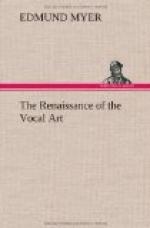Much has been written lately on the subject of open tones. Should the tones be opened or closed, is the question. Tone should never be closed. It should always be open, but never out. If it is out of the mouth it is not a singing sound. Even the real covered tones of the voice should never be closed. The truth is, the form of the covered tones of the voice, through elongation, is larger than the form of those which we call the open tones, in contradistinction to the covered.
In the clear timbre of the voice, the bright tone, the ring of high placing, predominates. In somber timbre, the dark tone, low resonance, or low color, predominates. In medium tone both are heard or felt more equally. None of this coloring or reinforcing must be done by locally influencing form or placing. The voice must be perfectly free; and the result must be due to sentiment, feeling, emotion, to the effect it may be desired to produce. If all restraint is removed, if true conditions prevail, this can always be done through the singer’s sensation, through the use of the third power. It is marvelous how, under right conditions, the voice will respond to thought, to sentiment, to feeling.
“The tone thus produced and thus delivered, with perfect breath-control, will set the whole body sympathizing, from the sole of the foot to the crown of the head. And it is only tones like these—that it is possible to so adorn, and decorate, and beautify, with the due amount of emphasis, and accurate intensity of emotional feelings, and exquisitely shaded and ever-varying tinges of color in expression—that can prove capable of captivating the heart of the hearer, that can graphically impress the listener with such sentiments as the vocalist desires to convey.”
We will take for our first study a single tone about the middle of the voice. In studying placing and resonance, we must of course observe all the rules laid down in regard to the action, position, etc. Do not take a voluntary breath before acting—do not start the tone before the action, two things which require constant watching on the part of the beginner. Either of them will virtually cause defeat.
Remove all obstruction by seeking the level of the tone through flexible action. Think the tone forward and high. Place by impulse, and never by local effort. Have the sensation as though the tone started forward and high, as though it impinged against the roof of the mouth, and instantly reflected into the low cavities, and especially into the chest. In doing this, relax the jaw, let go all face and throat contraction, expand the body, and think and feel the chest vibrant and filled with tone. In this way the tone may be started high and reinforced or built down by the added resonance of all the inflated cavities.




